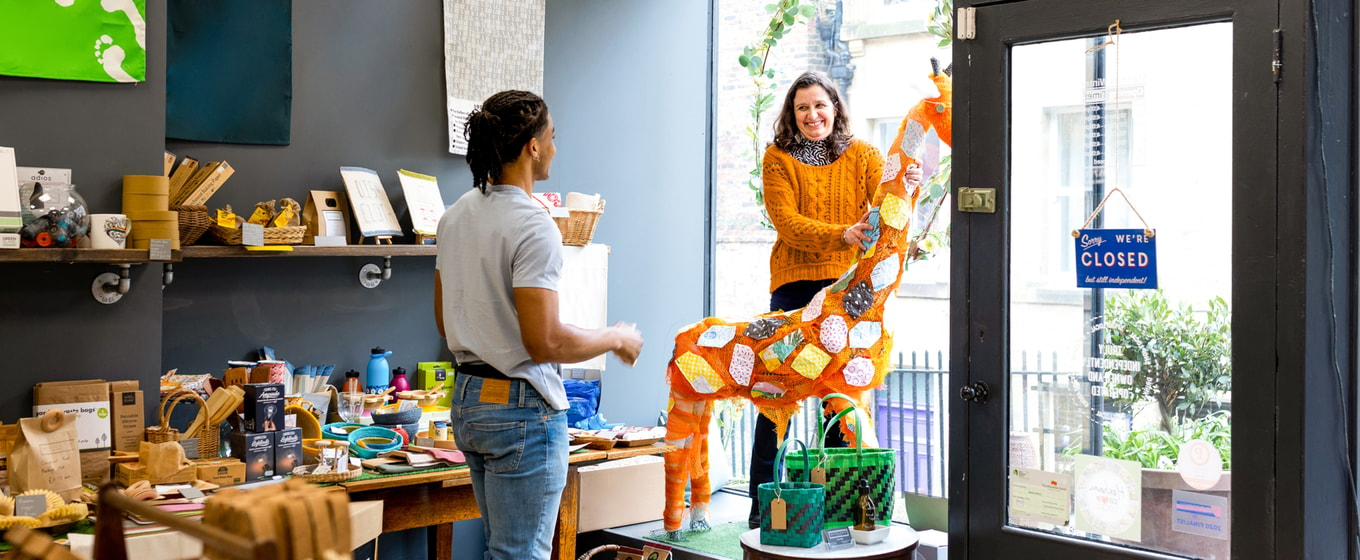Shopping habits have undergone a drastic transformation over the last two decades, resulting in growing concerns among retailers that have a physical presence.
As more consumers switch to shopping online, shop owners have struggled to generate enough sales to stay open, with brick-and-mortar stores gradually disappearing from towns and cities across the UK.
Retail footfall in British highstreets bounced back from the pandemic-driven sluggish shopper numbers around January 2023. But despite the recovering numbers, high streets still struggled with diminishing visits.
Wherever you're based, getting customers to shop with you over rival stores can be difficult. And with fewer people visiting their local high street, the competition is fierce. To help the independent retail community during this time, we've put together nine tips to increase shop visits and boost your takings.
1. Create a welcoming shopfront
To persuade passing shoppers to step inside your store, it’s important that your brand makes a good first impression. This means creating a shopfront that is uncluttered, welcoming, and attractive. You may also want to spend some extra time on your visual merchandising.
Creating seasonal window displays that mark these occasions, whether it’s Summer holidays, Halloween, Valentine’s Day, or Christmas, featuring your most in-demand items can increase your footfall throughout the year.
2. Try product demos and deals
It’s also a great idea to take your business out into the streets and engage with potential customers. There are many ways to encourage shop visits through street marketing, such as product demonstrations, promotional flyers, free samples, and discount vouchers, which can be highly effective for boosting footfall.
While online marketing has its advantages, creating face-to-face interactions with your target market can inspire an emotional connection and sense of consumer trust that’s tricky to recreate digitally.
3. Provide a loyalty scheme
To boost your brand and build repeat business, why not start a customer loyalty scheme? It's a great tool for bringing people back time and again.
Whether you're a local supermarket or an independent bookshop, giving your customers rewards in return for their repeat custom is a powerful customer engagement method. Not only does the customer feel valued, but they also have an incentive to visit regularly, which is crucial for any business.
4. Use local marketing
It’s vital to market your shop to the local community using tactics like direct mail, leaflets, and magazine ads. You could also buy a street sign to place in a high-footfall area, which displays clear directions to your shop and your special offers.
There's also the option of sponsoring local events such as charity runs, community fairs, or business breakfasts. Providing you execute some market research beforehand, you could find the perfect opportunity to get your brand in front of the right people.
5. Leverage new technology
Creating a seamless omnichannel experience was a high priority for retailers even before the pandemic. This means that customers can engage with your brand through different channels, from your website to your brick-and-mortar store, without any inconvenience or disruption.
For example, eCommerce technologies that let customers order online and pick up in-store, or check for product availability before visiting your shop, provide easy, flexible shopping options that drive traffic to your physical store.
Technology can also manage customer expectations. You may consider implementing a smart queuing system that allows customers to queue virtually and avoid overcrowding. This will prevent people from becoming bored or frustrated by long lines, and increase their willingness to wait.
6. Invest in CRM
A customer relationship management (CRM) system is crucial to understanding your target audience, delivering personalised marketing, and fulfilling consumer demand.
By gathering data on your customers you can spot where you’re not servicing them and adjust your offering. This is vital to retaining your existing customers and building a reputation among new ones.
Although retailers tend to use online surveys via their website or emails, it’s possible to collect this information in person with prompt cards at your checkout, or by training your staff to ask for feedback.
7. Diversify your in-store offering
Whilst your primary focus should be selling your products and services, sometimes those small touches can elevate the overall shopping experience and keep your customers coming back for more.
We're not necessarily encouraging you to build an entire cafe within your premises, but some bricks and mortar shops have started serving finger food and the odd beverage here and there to make their customers feel welcome and relaxed as they peruse the goods on offer.
8. Encourage sharing on customer socials
According to 2022 Visual Objects research, social media is the top digital marketing tool for 67% of small businesses. Why not create advocates for your brand or services by encouraging your customers to share their retail experience across their social media accounts?
A simple way of doing this could be by adding branded hashtags to changing room mirrors or by having a highly decorated, 'Instagrammable' backdrop within your premises.
9. Relocate
If you’re currently situated in an area that lacks investment, struggles to attract tourists, has a high proportion of vacant lots, or charges expensive business rates, moving to new premises could dramatically boost your customer visits and your shop sales in the long term.
Need funding to boost your retail business?
Implementing these strategies can take time and investment, whether it’s upgrading your shopfront, adopting new technology, or relocating to a better location. If you’re looking for financial support to make these changes, explore our flexible retail business loans designed to help retail businesses grow and attract more customers.









These cookies are set by a range of social media services that we have added to the site to enable you to share our content with your friends and networks. They are capable of tracking your browser across other sites and building up a profile of your interests. This may impact the content and messages you see on other websites you visit.
If you do not allow these cookies you may not be able to use or see these sharing tools.